617 Search Results for tell me about it
November 17, 2015
by Carole Zangari -

It’s hard to get to every conference where high-quality information on AAC implementation is being shared. Here are some handouts on AAC implementation from presentations you may have missed. Models of Parent-implemented AAC Intervention for Children with Severe Autism (Wendt, et al 2014) AAC in the Pediatric ICU/Acute Care: Preparing a Child for an Upcoming Hospital Admission (Santiago, 2013) Teaching Preschoolers with Unintelligible Speech to Produce Rule-Based Sentences: AAC Solutions (Binger, 2014) Supporting Beginning Storytellers Who Use AAC (McLellan, 2014) Strategies for SLPs Working with Students with AAC Needs in Schools (Phillips, 2014)
July 9, 2015
by Carole Zangari -
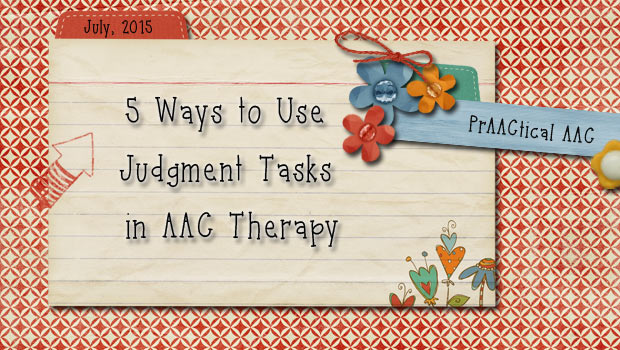
Judgment tasks refer to situations in which we present some examples and have the learner pass judgment on them. They can be examples of words used correctly/incorrectly, word endings used properly/improperly, or responses that fit well/poorly with a situation. We can set them up so that the learner weighs in with a binary judgment (e.g. thumbs up/down), gives them points (e.g., 2 points=perfect, 1=good, 0=wrong), a letter grade (e.g., A+ to F), or rates on a scale (e.g.,Excellent Okay Terrible). There are several reasons why I love judgment tasks. It can be a fun, low-stress way to increase their awareness of specific linguistic concepts. Think of it as giving them receptive exposure to the concept. In these tasks, we’re highlighting the concept but not expecting them to produce it. They put the learner in a position of power. Our prAACtical friends often don’t get enough experiences with that role, so... [Read More...]
June 16, 2015
by Carole Zangari -
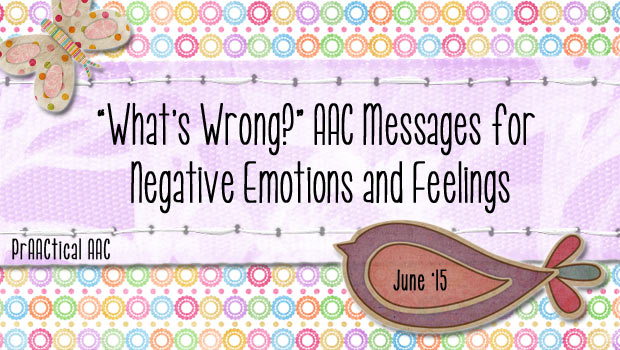
Pain. Fear. Anger. Frustration Parents and teachers frequently ask SLPs to help learners further develop the skill of being able to say what is troubling them. Those are skills worth developing, of course. But a first step may be to review the vocabulary and messages available to the learner and consider making some adjustments. It is fine to be able to say what is wrong, but it’s even better to be able to explain what happened and what kind of help you might need. Here are some ideas for messages to consider. Sadness Because…[I remembered a sad thing that happened; Something happened to me; I’m lonely; I miss someone; I was left out; Someone got hurt. Something else.] It would help if…[add student’s preferred solution strategies Anger Because…[Something bad happened; I want to do something else; Someone hurt me; It’s unfair; I’m not sure why; Something else.] I need…[Some time... [Read More...]
June 2, 2015
by Carole Zangari -

Jill Senner and Matthew Baud are back to share some of their favorite therapy activities. In this post, they discuss how they build language while making ice cream. Summer is almost here and we’re already thinking about making our favorite frozen treat, ice cream in a bag. No special equipment is required. With a couple of plastic zipper bags and 5 ingredients already in your kitchen, kids can shake milk into ice cream in just 5 minutes. Free picture recipes can be downloaded here. As with many of the cooking activities we love, there are lots of natural opportunities for language use before, during and after cooking. Before cooking we read the recipe and check the kitchen to see if we have the ingredients. If any are missing, we write shopping lists of ingredients we need. We can take a community field trip to the grocery store where there... [Read More...]
May 12, 2015
by Carole Zangari -
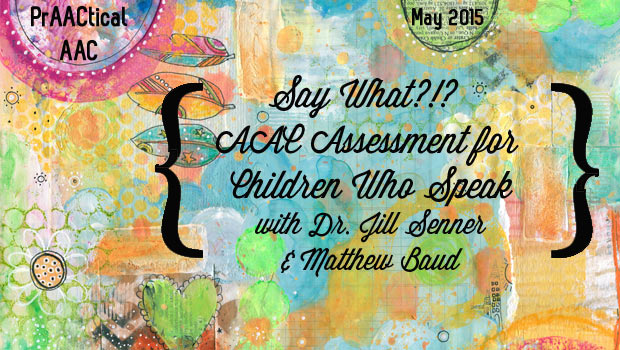
While the Index of Augmented Speech Comprehensibility in Children (I-ASCC) has been around for almost 20 years, few clinicians know and use it. In this post, we welcome back Matthew Baud and Jill Senner to talk about how they are using this assessment tool. Enjoy! AAC evaluations can be challenging, especially if there is disagreement among team members as to whether AAC is necessary or not. We frequently see disagreements about AAC arise when a student is able to speak. Let’s examine the following case. Mrs. Brown has had Johnny in her class for the last 2 years and she “understands everything” he is saying during their routine calendar time. The new SLP, who only sees Johnny once weekly for 30 minutes, tried to elicit information about his weekend at home and reported that she “didn’t understand anything.” What is going on here? How can two communication partners have such vastly... [Read More...]
February 12, 2015
by Carole Zangari -

Those of you who are still digging your way out of the most recent snowstorm may not believe it, but it’s almost time to make plans for summer. There are quite a few AAC camps, some that are quite well established and others that have been running for only a few years (see our AAC Camp Pinterest board here). In this post, we hear about one of them from Tina Moreno, an SLP and mom of Mateo, who uses PicturePower 100 on the Maestro to communicate, maintain friendships with his teammates on the cross country team, advocate for himself, reveal his wicked sense of humor, and even sing the National Anthem for his high school’s basketball games. Tina blogs at Voices4All. With the help of Drs. Karen Erickson and David Koppenhaver, she and her friend Gina Cunningham created Camp ALEC together in memory of Gina’s son Alec, who never gave up, and... [Read More...]
January 19, 2015
by Carole Zangari -
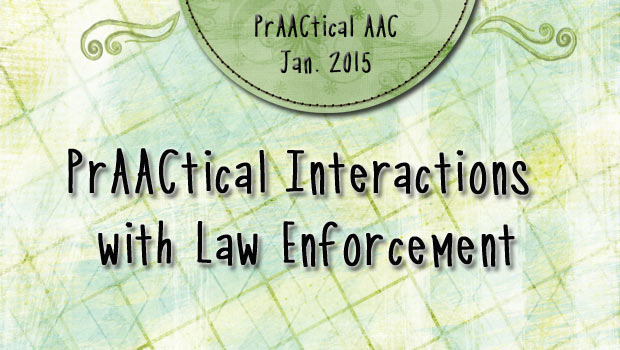
If you were ever stopped by the police, you know that it can be an anxiety-producing situation. Even when you’ve done nothing wrong, your heart may race, your hands may tremble, and you may stumble over your words. It is easy to imagine how much more difficult these situations would be for those with speech disabilities, particularly those with problems in social interaction. At a meeting a few weeks ago, I was excited to learn about The Wallet Card Project, a collaborative effort between the Disability Independence Group, the Coral Gables Police Department, and the UM-NSU Center for Autism and Related Disabilities (UM-NSU CARD). The Wallet Card Project created free materials to be used in helping individuals with Autism Spectrum Disorder (ASD) and their families gain skills in interacting successfully with police. The trainings address applicable laws in an easy-to-understand fashion that includes both real examples and hypothetical scenarios. Participants... [Read More...]
September 23, 2014
by Carole Zangari -
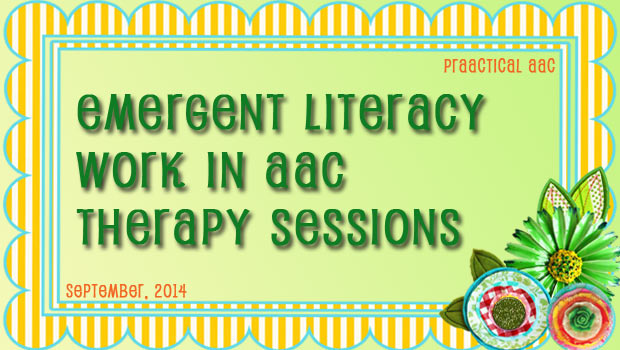
We strive to use some of our therapy time to build the literacy skills with all of our beginning communicators. It’s not easy. First, because they often have little to no interest in it (at first), but mostly because our time together is quite limited. Here are some of the things we’ve been doing. Having our clients sign in themselves (Think: name stamps, stickers, tracing, or even making a mark) Looking for their name on their therapy room door: We make signs and print two copies. We give them one in the waiting room so that they can match it to the sample on the door. Formatting the visual schedule so that the client does some writing (Think: check box, crossing off the activity when finished) Picking a book or the topic: For some of clients we use the books themselves, but for most we use their AAC. It’s time... [Read More...]
September 22, 2014
by Carole Zangari -
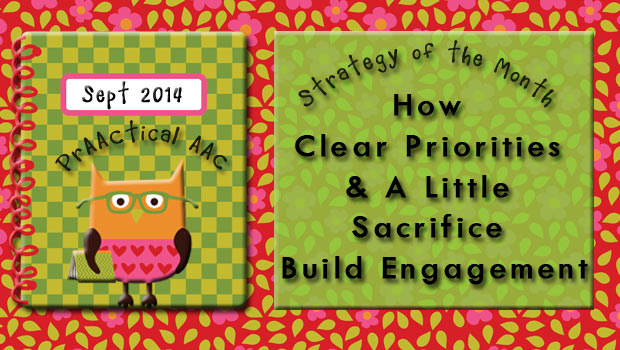
We can’t complete our thoughts on engaging AAC learners without a bit of conversation around the topic of priorities. Here’s the main idea: Go into each activity having a clear priority for what you want to achieve. Everything else become negotiable. As SLPs, sometimes we want it all. We want therapy activities where the AAC learner initiates communications, uses new vocabulary, creates novel sentences, experiments with new grammatical forms, and kicks some morphological butt. We.want.it.all. After a few decades of being an AAC practitioner, I think I’m finally learning that trying to have it all isn’t always the best option. It isn’t about what I want, it’s about what my client needs. Sigh. In this approach, we look at the lesson or activity and create our “Must Have List.’ For Mayra, a kindergartner just learning to use symbols for the first time, our lessons ‘must’ be engaging, have high pay-off... [Read More...]
September 18, 2014
by Carole Zangari -
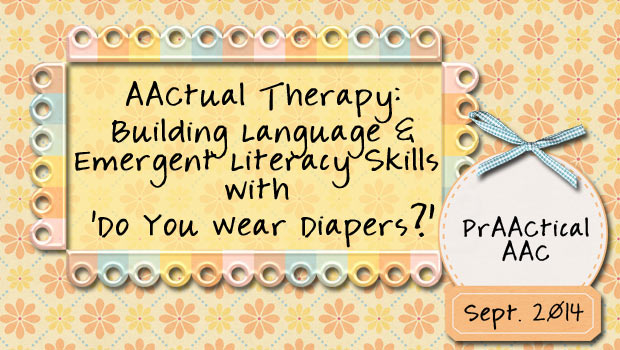
What’s more fun than using story books to teaching language to young children with AAC needs? Today, we hear from Kimberly Scanlon, an SLP practicing in New Jersey. Kimberley is is a devoted mom, wife and dog lover and blogs at Scanlon Speech and My Toddler Talks. She is the author of My Toddler Talks: Strategies and Activities to Promote Your Child’s Language Development and is finishing a unique picture and activity workbook, Learning to Read is a Ball. ::::::::::::::::::::::::::::::::::::::::::::::::::::::::::: Hold on to your undies, today we’re going to talk about poop, diapers, and the location of where various animals go potty. Sounds like a good time, right? Kidding aside, in this post I’m going to show you how to use this adorable picture book, Do You Wear Diapers? by Tanya Roitman to facilitate language and emergent literacy development in toddlers and preschoolers. What’s this book about? It’s a potty book! This adorable board book... [Read More...]









